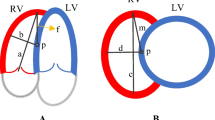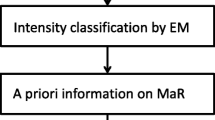Abstract
Background
Accurate alignment between cardiac CT angiographic studies (CTA) and nuclear perfusion images is crucial for improved diagnosis of coronary artery disease. This study evaluated in an animal model the accuracy of a CTA fully automated biventricular segmentation algorithm, a necessary step for automatic and thus efficient PET/CT alignment.
Methods and Results
Twelve pigs with acute infarcts were imaged using Rb-82 PET and 64-slice CTA. Post-mortem myocardium mass measurements were obtained. Endocardial and epicardial myocardial boundaries were manually and automatically detected on the CTA and both segmentations used to perform PET/CT alignment. To assess the segmentation performance, image-based myocardial masses were compared to experimental data; the hand-traced profiles were used as a reference standard to assess the global and slice-by-slice robustness of the automated algorithm in extracting myocardium, LV, and RV. Mean distances between the automated and the manual 3D segmented surfaces were computed. Finally, differences in rotations and translations between the manual and automatic surfaces were estimated post-PET/CT alignment. The largest, smallest, and median distances between interactive and automatic surfaces averaged 1.2 ± 2.1, 0.2 ± 1.6, and 0.7 ± 1.9 mm. The average angular and translational differences in CT/PET alignments were 0.4°, −0.6°, and −2.3° about x, y, and z axes, and 1.8, −2.1, and 2.0 mm in x, y, and z directions.
Conclusions
Our automatic myocardial boundary detection algorithm creates surfaces from CTA that are similar in accuracy and provide similar alignments with PET as those obtained from interactive tracing. Specific difficulties in a reliable segmentation of the apex and base regions will require further improvements in the automated technique.







Similar content being viewed by others
References
Gaemperli O, Schepis T, Kalff V, Namdar M, Valenta I, Stefani L, et al. Validation of a new cardiac image fusion software for three-dimensional integration of myocardial perfusion SPECT and stand-alone 64-slice CT angiography. Eur J Nucl Med Mol Imaging 2007;34:1097-106.
Santana CA, Garcia EV, Faber TL, Sirineni GKR, Esteves FP, Sanyal R, et al. Diagnostic performance of fusion of myocardial perfusion imaging (MPI) and computed tomography coronary angiography. J Nucl Cardiol 2009;16:201-11.
Kajander S, Joutsiniemi E, Saraste M, Pietila M, Ukkonen H, Saraste A, et al. Cardiac positron emission tomography/computed tomography imaging accurately detects anatomically and functionally significant coronary artery disease. Circulation 2010;122:603-13.
Sato A, Nozato T, Hikita H, Miyazaki S, Takahashi Y, Kuwahara T, et al. Incremental value of combining 64-slice computed tomography angiography with stress nuclear myocardial perfusion imaging to improve non-invasive detection of coronary artery disease. J Nucl Cardiol 2010;17:19-26.
Faber TL, Santana CA, Garcia EV, Candell-Riera J, Folks RD, Peifer JW, et al. Three-dimensional fusion of coronary arteries with myocardial perfusion distributions: Clinical validation. J Nucl Med 2004;45:745-53.
Garcia EV, Faber TL, Cooke CD, Folks RD, Chen J, Santana C. The increasing role of quantification in nuclear cardiology: The Emory approach. J Nucl Cardiol 2007;14:420-32.
Germano G, Kavanagh PB, Slomka PJ, Van Kriekinge SD, Pollard G, Berman DS. Quantitation in gated perfusion SPECT imaging: The Cedars-Sinai approach. J Nucl Cardiol 2007;14:433-54.
Schoepf UJ, Becker CR, Ohnesorge BM, Yucel EK. CT of coronary artery disease. Radiology 2004;232:18-37.
Mowatt G, Cook JA, Hillis GS, Walker S, Fraser C, Jia X, Waugh N. 64-slice computed tomography angiography in the diagnosis and assessment of coronary artery disease: Systematic review and meta-analysis. Heart 2008;94:1386-93.
Schindler TH, Magosaki N, Jeserich M, Oser U, Krause T, Fisher R, et al. Fusion imaging: Combined visualization of 3D reconstructed coronary artery tree and 3D myocardial scintigraphic image in coronary artery disease. Int J Cardiovasc Imaging 1999;15:357-68.
Faber TL, Santana CA, Piccinelli M, Nye JA, Votaw JR, Garcia EV, et al. Automatic alignment of myocardial perfusion images with contrast-enhanced cardiac computed tomography. IEEE Trans Nucl Sci 2011;58:2296-302.
Wells WM, Viola P, Atsumi H, Nakajima S, Kikinis R. Multi-modal volume registration by maximization of mutual information. Med Image Anal 1996;1:35-51.
Faber TL, Cooke CD, Folks RD, Vansant JP, Nichols KJ, DePuey EG, et al. Left ventricular function and perfusion from gated SPECT perfusion images: An integrated method. J Nucl Med 1999;40:650-9.
McInerney T, Terzopoulos D. Deformable models in medical image analysis: A survey. IEEE Trans Med Imaging 1996;1:91-108.
Paragios N. A variational approach for the segmentation of the left ventricle in cardiac image analysis. Int J Comput Vis 2002;50:345-62.
Petitjean C, Dacher JN. A review of segmentation methods in short axis cardiac MR images. Med Image Anal 2011;15:169-84.
Tsai A, Yezzi A, Wells W, Tempany C, Tucker D, Fan A, et al. A shape-based approach to the segmentation of medical imagery using level sets. IEEE Trans Med Imaging 2003;22:137-54.
Heimann T, Meinzer HP. Statistical shape models for 3D medical segmentation: A review. Med Image Anal 2009;13:543-63.
Appia VV, Ganapathy B, Abufadel A, Yezzi A, Faber TL. A regions of confidence based approach to enhance segmentation with shape priors. Proc SPIE 2010;18:7533.
Appia VV, Ganapathy B, Yezzi A, Faber TL. Localized principal component analysis based curve evolution: A divide and conquer approach. In: IEEE international conference on computer vision; 2011. p. 1981-86.
Halkos ME, Zhao ZQ, Kerendi F, Wang NP, Jiang R, Schmarkey LS, et al. Intravenous infusion of mesenchymal stem cells enhances regional perfusion and improves ventricular function in a porcine model of myocardial infarction. Basic Res Cardiol 2008;103:525-36.
Machac J, Bacharach SL, Bateman TM, Bax JJ, Beanlands R, Bengel F, et al. Positron emission tomography myocardial perfusion and glucose metabolism imaging. J Nucl Cardiol 2006;13:e121-51.
Faber TL, Cooke CD, Peifer JW, Pettigrew RI, Vansant JP, Leyendecker JR, et al. Three-dimensional displays of left ventricular epicardial surface from standard cardiac SPECT perfusion quantification techniques. J Nucl Med 1995;36:697-703.
Florentine MS, Grosskreutz CL, Chang W, Hartnett JA, Dunn VD, Ehrhardt JC, et al. Measurements of left ventricle mass in vivo using gated nuclear magnetic resonance imaging. J Am Coll Cardiol 1986;8:107-12.
Bruners P, Mahnken AH, Knackstedt C, Luhmann N, Spuntrup E, Das M, et al. Assessment of global left and right ventricular function using dual-source computer tomography (DSCT) in comparison to MRI. An experimental study in a porcine model. Investig Radiol 2007;42:756-64.
Zhu L, Appia V, Yezzi A, Arepalli C, Faber T, Stillman A, et al. Automatic delineation of the myocardial wall from CT images via shape segmentation and variational region growing. IEEE Trans Biomed Eng 2013;60:2887-95.
Woo J, Slomka PJ, Dey D, Cheng VY, Hong BW, Ramesh A, et al. Geometric feature-based multimodal image registration of contrast-enhanced cardiac CT with gated myocardial perfusion SPECT. Med Phys 2009;32:5467-79.
van Assen HC, Danilouchkine MG, Dirksen MS, Reiber JHC, Lelieveldt BPF. A 3D active shape model driven by fuzzy inference: Application to cardiac CT and MR. IEEE Trans Inf Technol Biomed 2008;12:595-605.
Ecabert O, Peters J, Schramm H, Lorenz C, von Berg J, Walker MJ, et al. Automatic model-based segmentation of the heart in CT images. IEEE Trans Med Imaging 2008;27:1189-201.
Acknowledgments
This work was supported in part by NIH Grant R01-HL-085417 from NHLBI and by the EMTech Bio Collaborative Grant program.
Conflict of interest
Some of the authors (EG, RF, TF) receive royalties from the sale of the Emory Cardiac Toolbox and have equity positions with Syntermed, Inc., which markets ECTb. The terms of these arrangements have been reviewed and approved by Emory University in accordance with its conflict of interest policies. The remaining authors do not have any conflicts of interest.
Disclosures
None.
Author information
Authors and Affiliations
Corresponding author
Additional information
Dr. Tracy L. Faber, this project’s principal investigator, passed away on March 24, 2012.
Rights and permissions
About this article
Cite this article
Piccinelli, M., Faber, T.L., Arepalli, C.D. et al. Automatic detection of left and right ventricles from CTA enables efficient alignment of anatomy with myocardial perfusion data. J. Nucl. Cardiol. 21, 96–108 (2014). https://doi.org/10.1007/s12350-013-9812-1
Received:
Accepted:
Published:
Issue Date:
DOI: https://doi.org/10.1007/s12350-013-9812-1




